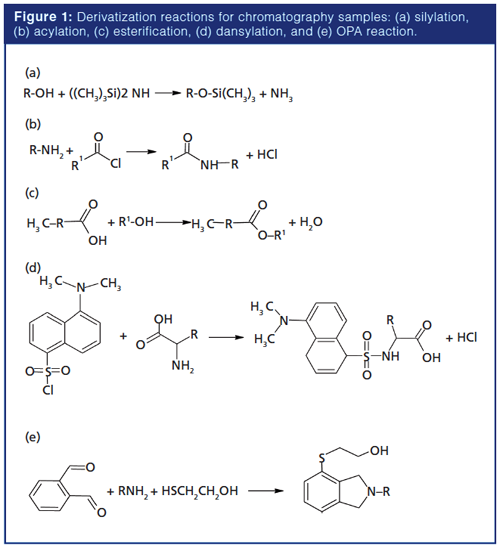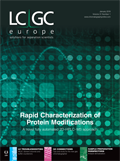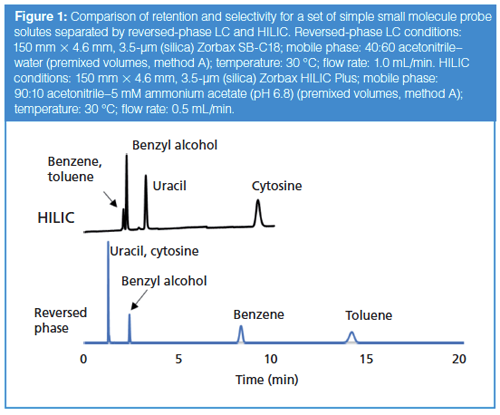Analyte Derivatization as an Important Tool for Sample Preparation
LCGC Europe
During the developmental stages of chromatography, the use of sample derivatization was prevalent either to render difficult-to-separate analytes ready for chromatography or to improve analyte detectability. As chromatography techniques advanced, including detection, the need for derivatization was less pronounced. Today, there is a resurgence of interest in derivatization schemes; however, the new generation of separation scientists is not as well-versed in these reactions. Some of this resurgence is for newer purposes, such as combining two or more derivatizations for the analysis of multiple compound classes, or to develop greener approaches. In this month’s instalment, we explain the use of chemical derivatization in the separation sciences, generally, and in sample preparation specifically.
Douglas E. Raynie, Sample Preparation Perspectives Editor
During the developmental stages of chromatography, the use of sample derivatization was prevalent either to render difficult-to-separate analytes ready for chromatography or to improve analyte detectability. As chromatography techniques advanced, including detection, the need for derivatization was less pronounced. Today, there is a resurgence of interest in derivatization schemes; however, the new generation of separation scientists is not as well-versed in these reactions. Some of this resurgence is for newer purposes, such as combining two or more derivatizations for the analysis of multiple compound classes, or to develop greener approaches. In this month’s instalment, we explain the use of chemical derivatization in the separation sciences, generally, and in sample preparation specifically.
It is said that you always remember your first time. The first professional conference I attended was the 1984 Spring Symposium of the Minnesota Chromatography Forum and, as I recall, the keynote was delivered by Colin Poole, then a young, up-andâcoming assistant professor at Wayne State University. I remember him remarking that in any organization’s parking lot, the most beat-up cars belonged to the chromatographers since they were mechanically inclined problem solvers. He also stated that derivatization was as close to doing organic chemistry as chromatographers get. (I also remember that my talk immediately followed a wine-tasting event, but that’s another story.) At the time, derivatizing an analyte by adding a suitable functional group to alter its chromatographic properties was somewhat commonplace. Improvements in both chromatographic media and detection schemes since the 1990s have rendered it less necessary, but in several instances sample derivatization is still needed. Since there has been less emphasis on these reactions over the past decade or so, much of the requisite background knowledge is missing. This month we look at the rationale behind derivatization as part of an overall chromatographic analysis scheme and provide an overview of some of the key reactions used.
Why Derivatize?
There are a few cases where modification of the analyte structure is used to improve chromatographic separation. For example, polar molecules are quite often nonvolatile, so they are difficult to separate by gas chromatography (GC). As polarity increases, the likelihood of interactions with surface silanols or other active sites on chromatographic media also increases. One very common example, discussed in the February 2014 “Sample Preparation Perspectives” column (1), is the conversion of free fatty acids to their methyl esters. By reacting the acidic hydrogen on the carboxyl group, peak tailing is reduced. Not coincidentally, the decreased strength of the intermolecular interactions also creates a more volatile compound, the free fatty acid methyl ester (FAME). Other examples of derivatization to reduce analyte polarity and increase volatility are trimethylsilyl ethers of sugars, steroids, and alkaloids; acylation of amines; and complexation of metals. Similar to improving chromatographic separation by decreasing analyte polarity, in the early days of GC, derivatization could also be used to increase the thermal stability of the analyte. However, as liquid chromatography (LC) performance improved with developments of more reproducible packing materials, the need for derivatization has subsided.
A final reason to derivatize samples for chromatographic analysis is to improve detection, including associated selectivity advantages. As we will see, chromophores or fluorophores can be added to solute molecules to improve their absorbance in the ultraviolet–visible (UV–vis) range or their fluorescence properties. Examples of UV–vis chromophores and their maximum absorption wavelength include benzyl (254 nm), 4-nitrobenzyl (265 nm), benzoate (230 nm), toluoyl (236 nm), anisyl (262 nm), and 2-naphthacyl (248 nm) functional groups. It is not uncommon for these derivatives to have molar absorption coefficients significantly greater than 10,000. In GC, compounds may be fluorinated to make them respond in electronâcapture detection (ECD). More recently, derivatization has been increasingly used to adjust ionization properties for mass spectrometry (MS).
Of course, derivatization is not limited to GC and LC. It has been applied, with the same rationale, to supercritical fluid chromatography (SFC) (2) and is widely used in spectroscopic analysis.
Derivatization in chromatographic analysis is generally classified as pre- or post-column. These reactions must be rapid and quantitative. The addition of cost, time, and sample handling are viewed as drawbacks to derivatization. For precolumn derivatization, the product compound must be stable, consequently the time lag between derivatization and injection into the chromatographic system is generally minimized. Often the reaction takes place in amber-glass vials. A number of vendors of chromatography supplies offer premeasured ampoules or other ready-to-go reagent kits for derivatization. Some precolumn derivatization schemes allow for the reactions to take place during sample extraction or inside the heated GC inlet. Post-column derivatization occurs between the chromatographic separation and detection. Hence, extracolumn band broadening is a major concern, as is the necessity of rapid reaction kinetics. These concerns are generally alleviated by specific reaction modules that are available from several vendors.
There are a number of books, book chapters, and published articles on derivatization for chromatography. Chromatography supply vendors that market derivatizing agents are also good sources of reagents and schemes for specific purposes. Relatively current review articles, perused in the preparation of this column, include references 3–5.
Derivatization Reactions
As stated, a number of derivatization reactions exist that cannot all be discussed in this article. To give practicing chromatographers an idea of the types of reactions they may consider, a brief overview of the most generally used types of derivatization schemes is presented below.

Silylation: We’ve mentioned that trimethylsilyl ethers can improve the volatility of highly polar compounds, making these analytes amenable to GC. A number of silylating reagents are available, depending on the analyte of interest, and each works by adding a silazane to an acidic hydrogen of the reacting molecule. One general example, shown in Figure 1(a), is the reaction of a hydroxyl group with the derivatizing reagent hexamethyldisilazane (HMDS) to form the trimethylsilyl ether.
Available silylating reagents include TMSIM (N-trimethylsilylimidazole), BSTFA (N,O-bis(trimethylsilyl)trifluoroacetamide), BSA (N,O-bis(trimethylsilyl)acetamide), MSTFA (N-methyl-N-trimethylsilyltrifluoroacetamide), TMSDMA (N,N-dimethylaminotrimethylsilane), TMSDEA (N-trimethylsilyldiethylamine), and TMCS (trimethylchlorosilane). Each of these agents may be preferred for various target functionalities, but they generally react fastest in the order presented and they react more preferentially in the order alcohols > phenols > carboxylic acids > amines > amides.
Acylation, Akylation, and Arylation: These reagents accomplish much of the same purposes as silylating agents, but generally react with hydroxyl, thiol, and amino groups and not carboxylic groups. The resulting esters, thioesters, and amines are often more thermally stable. The acylating reagents may be halogenated to provide detection advantages in GC or with aromatic chromophores for spectroscopic detection in LC. A general scheme for acylation is shown in Figure 1(b).
The resulting compounds are much easier to store than the previously presented silyl derivatives. The reagents used in these reactions are highly dependent on the target group and readers are referred to more comprehensive treatments of the topic (4).
Esterification: FAME analysis is used for compliance with the U.S. Nutritional Labeling and Education Act (NLEA), the informative labels required by the Food and Drug Administration on prepared food products. When the NLEA was created, MS detection was generally not as well developed, and hence not widely available, for LC applications and the triglycerides present in fatty foods are not volatile for GC. So acid hydrolysis of the triglycerides to the component free fatty acids followed by catalytic esterification, such as using BF3 in methanol, to the FAME is the widely accepted approach for NLEA purposes, as shown in Figure 1(c).
This method is also commonly used in the identification of bacterial types and similar analyses involving determination of lipid composition.
Addition of Chromophores: Given the preponderance of UV–vis detectors for LC, a number of schemes to add absorbing moieties (that is, chromophores) exist. As expected, these will vary widely depending on the reacting functional groups present on the analyte of interest. Commonly used reagents include dabsyl chloride (4-dimethylaminoazobenzene-4-sulfonyl chloride), DNBA (3,5-dinitrobenzyloxyamine hydrochloride), NIC-1 (1-naphthylisocyanate), PBPB (p-bromophenacyl bromide), PNBA (p-nitrobenzyloxyamine hydrochloride), PNBDI (p-nitrobenyl-N,N’-diisopropylisourea), DNBDI (3,5-dinitrobenzyl-N,N’-diisopropylisourea), PNBPA (p-nitrobenzyl-N-n-propylamine hydrochloride), DNBPA (3,5-dinitrobenzyl-N-n-propylamine hydrochloride), SNPA (N-succinimidyl-p-nitrophenylacetate), SDNPA (N-succinimidyl-3,5-dinitrophenylacetate), and DNBC (3,5-dinitrobenzyl chloride).
Addition of Fluorophores: Similar to the addition of chromophores, functional groups sensitive to fluorescence detection can also be added, and provide an added degree of detection selectivity. Such derivatizing agents include NBD-Cl (7-chloro-4-nitrobenzo-2-oxa-1,3-diazole), fluorescamine (4-phenylspirio(furan-2[3H],1’-phthalan-3,3’-dione), OPA (o-phthaldehyde), dansyl chloride (5-dimethylaminonaphthalene-1-sulfonyl chloride), BrMmC (4-bromomethyl-7-methoxycoumarin), and BrMaC (4-bromomethyl-7-acetoxycoumarin). The nitrobenzooxadiazole agents, such as NBD-Cl, are widely used for amines, amino acids, and amino sugars and can also be used to support electrochemical detection. Two of these reagents, OPA and dansyl chloride, are seeing increased use in important applications and are discussed further below.
Dansylation: In addition to fluorescence, dansylation may also improve ionization properties of compounds in LC–MS analysis. In particular, this reaction is used for amines, carbonyls, and phenols. Therefore, it has found great utility in protein characterization. The dansylation procedure is shown in Figure 1(d).
OPA: OPA is commonly used in post-column derivatization schemes for the determination of primary amines by LC-fluorescence. OPA, with a mercapto-alcohol, reacts with the primary amine to form a highly fluorescent isoindole molecule, as shown in Figure 1(e). For example, we have used this derivatization for the determination of antibiotic combinations in animal feeds (6).
Mass Spectrometry Applications: Newer uses of derivatization include improvements in ionization efficiency in MS, especially for the soft-ionization approach typically used with LC. Silylation, acylation, alkylation, cyclization, and mixed derivatives can all be used for this purpose, though readers are directed to specific research articles (7).
Recent Advances
Like many organic reactions, derivatization schemes are under scrutiny from a green chemistry perspective (5). Investigations are underway to lower their environmental impact by reduction of chemical waste, solvent substitution, and decreased energy use-all of which also result in improved laboratory safety. For example, if the reaction can occur in a heated GC inlet, energy use during an isolated reaction disappears. Other approaches to develop greener derivatization schemes include
- the use of less toxic reagents by employing natural products or enzymes and solvents such as water or supercritical fluids,
- lower energy use by use of microwave irradiation, application of ultrasound, and photo- or electrochemistry,
- miniaturization for application to chip devices,
- automation,
- solid-phase reaction chemistry, and
- simultaneous extraction–derivatization.
Lavilla and colleagues (5) tabulate all of these approaches with specific references such as the use of greener molecular solvents for silylation, acylation in water, and use of ionic liquids combined with microwave heating. Nine different oxidative coupling reactions using phenoxazines combined with sulfonamides to replace more toxic sulfanilic acid and 1-naphthylamine is reported (8–10). Specific silylation, acetylation, and pentafluorobenzoylation with microwave heating, esterification and akylation using ultrasonic energy, and photoreductions are discussed (5).
Conclusions
As chromatography matured, the need for chemical derivatization to improve separations by increasing analyte volatility or solubility, reduce analyte polarity, or enhance detection has waned. Since the early days of chromatography, knowledge of derivatization schemes has been lost because their use has diminished. But a resurgence in derivatization schemes, often for improved detection, is upon us. An overview of these reactions was presented here to spark the interest of practicing chromatographers.
References
- D.E. Raynie, LCGC Europe27(2), 87–90 (2014).
- L.A. Cole, J.G. Dorsey, and T.L. Chester, Analyst116, 1287–1291 (1991).
- J. M. Rosenfeld, Comp. Anal. Chem.37, 609–668 (2002).
- D.R. Parkinson, Reference Module in Chemistry, Molecular Sciences and Chemical Engineering (Elsevier, 2014), pp. 559–595.
- I. Lavilla, V. Romero, I. Costas, and C. Bendicho, TrAc Trends Anal. Chem.61, 1–10 (2014).
- J.L. Driver, N. Thiex, D. Raynie, M. Ofitserova, and M. Pickering, J. AOAC Intl. 92, 34–41 (2009).
- B.-L. Qi, P. Liu, Q.-Y. Wang, W.-J. Cai, B.-F. Yuan, and Y.-Q. Feng, TrAc Trends Anal. Chem. 59, 121–132 (2014).
- R.A. Al-Okab and A.A. Syed, Talanta 72, 1239–1247 (2007).
- R.A. Al-Okab and A.A. Syed, J. Hazard Mater. 170, 292–297 (2009).
- R.A. Al-Okab, Spectrochim. Acta103, 333–337 (2013).
“Sample Prep Perspectives” editor Douglas E. Raynie is a Department Head and Associate Professor at South Dakota State University. His research interests include green chemistry, alternative solvents, sample preparation, high resolution chromatography, and bioprocessing in supercritical fluids. He earned his PhD in 1990 at Brigham Young University under the direction of Milton L. Lee. Raynie is a member of LCGC’s editorial advisory board. Direct correspondence about this column via e-mail to LCGCedit@ubm.com

New Study Reviews Chromatography Methods for Flavonoid Analysis
April 21st 2025Flavonoids are widely used metabolites that carry out various functions in different industries, such as food and cosmetics. Detecting, separating, and quantifying them in fruit species can be a complicated process.
Quantifying Terpenes in Hydrodistilled Cannabis sativa Essential Oil with GC-MS
April 21st 2025A recent study conducted at the University of Georgia, (Athens, Georgia) presented a validated method for quantifying 18 terpenes in Cannabis sativa essential oil, extracted via hydrodistillation. The method, utilizing gas chromatography–mass spectrometry (GC–MS) with selected ion monitoring (SIM), includes using internal standards (n-tridecane and octadecane) for accurate analysis, with key validation parameters—such as specificity, accuracy, precision, and detection limits—thoroughly assessed. LCGC International spoke to Noelle Joy of the University of Georgia, corresponding author of this paper discussing the method, about its creation and benefits it offers the analytical community.












